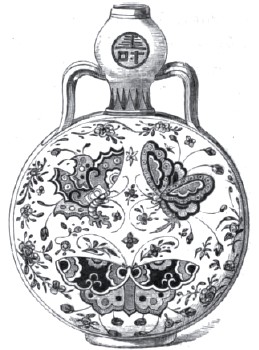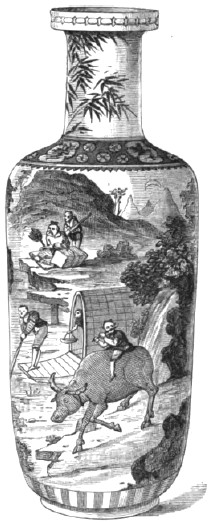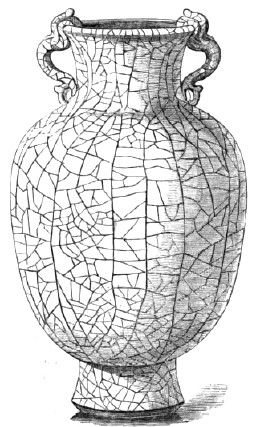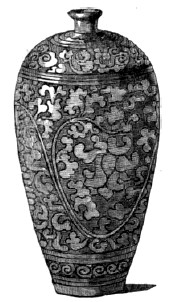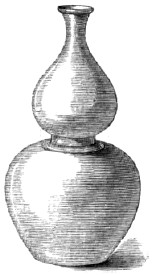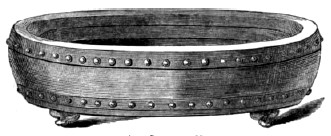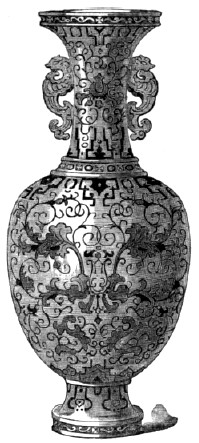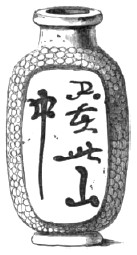| Web
and Book design,
Copyright, Kellscraft Studio 1999-2011 (Return to Web Text-ures) |
 (HOME)
|
| CHAPTER V. Visit a collector of ancient
works of art His house and
garden Inspect his collections of old crackle china and other vases,
&c.
Fondness of Chinese for their own ancient works of art Description
of
ancient porcelain most prized by them Ancient enamels Foo-chow
enamels
Jade-stone Rock crystal Magnetic iron and other minerals
Gold-stone Red
lacquer and gold japan Porcelain bottles found in Egyptian tombs
Found also
in China at the present day Age of these Mr. Medhurst's
remarks.
A SHORT time after the events took place
which I have
related in the last chapter, and before leaving this part of the
country, I
paid a visit to another Chinese gentleman, whose acquaintance I had
formerly
made in an old curiosity shop in Ningpo. Like myself he was an ardent
admirer
and collector of ancient works of art, such as specimens of china,
bronzes,
enamels, and articles of that description. Neither of us collected what
are
commonly known as curios, such as ivory balls, grotesque and ugly
carvings in
bamboo or sandalwood or soapstone, and such things as take the fancy of
captains of ships and their crews of jolly tars when they visit the
Celestial Empire.
Above all things, our greatest horror was modern chinaware, an article
which
proves more than anything else in the country how much China has
degenerated in
the arts. The venders of such things as
we were in the habit of collecting knew us both well, and not
frequently made
us pay for the similarity of our tastes. Oftentimes I was informed, on
asking
the price of an article, that my Tse-kee friend was anxious to get it,
and had
offered such and such a price, and I have no doubt the same game was
played
with him. That what they told me was sometimes true I have no doubt,
for in
more than one instance I have known specimens purchased by him the
moment he
heard of my arrival. But for all this rivalry we were excellent
friends, and he
frequently invited me to visit him and see his collections when I came
to
Tse-kee.
Curious
Pilgrim-shaped bottle,
enameled with butterflies & etc. I found him the owner and occupant of a
large house
in the centre of the city, and apparently a man of considerable wealth.
He
received me with the greatest cordiality, and led me in the usual way
to the
seat of honour at the end of the reception-hall. His house was
furnished and
ornamented with great taste. In front of the room in which I had been
received
was a little garden containing a number of choice plants in pots, such
as
azaleas, camellias, and dwarfed trees of various kinds. The ground was
paved
with sandstone and granite, and, while some of the pots were placed on
the
floor, others were standing on stone tables. Small borders fenced with
the same
kinds of stone were filled with soil, in which were growing creepers of
various
kinds which covered the walls. Here were the favoured Glycine
sinensis,
roses, jasmines, &c., which not only scrambled over the walls, but
were led
inward and formed arbours to afford shade from the rays of the noonday
sun. In
front of these were such things as Moutans, Nandina (sacred bamboo of
the
Chinese), Weigela rosea, Forsythia viridissima, and Spiræa
Reevesiana.
In opposite corners stood two noble trees of Olea fragrans, the
celebrated
"Kwei-hwa," whose flowers are often used in scenting tea; while many
parts of the little border were carpeted with the pretty little Lycopodium
cæsium, which I introduced to England some years ago. This pretty
fairy-like
scene was exposed to our view as we sat sipping our tea, and with all
my
English prejudice I could not but acknowledge that it was exceedingly
enjoyable. The reception-room was hung with numerous
square
glass lanterns gaily painted with "flowers of all hues;" several
massive varnished tables stood in its centre, while a row of chairs was
arranged down each side. Between the chairs stood small square tables
or
tepoys, on some of which were placed beautiful specimens of ancient
china
vases. Everything which met the eye told in language not to be mistaken
that
its owner was not only a man of wealth, but of the most refined taste. After a few commonplace civilities passing
between us
I expressed a wish to inspect his collections. He led me from room to
room and
pointed out a collection which was enough to make one's "mouth
water." In some instances his specimens stood on tables or on the
floor,
while in others they were tastefully arranged in cabinets made
expressly for
the purpose of holding them. He showed me many exquisite bits, of
crackle of
various colours grey, red, turquoise, cream, pale yellow, and indeed
of
almost every shade. One vase I admired much was about two feet high, of
a deep
blue colour, and covered with figures and ornaments in gold; another of
the
same height had a while ground with figures and trees in black, yellow,
and
green rare and bright colours lost now to Chinese art, and never
known in any
other part of the world.
Porcelain
vase enamelled with
figures of Animals & Plants In one of the
rooms I observed some handsome
specimens of red lacquer most elaborately and deeply carved, and also
fine
pieces of gold japan. There were also numerous bronzes and enamels on
copper,
which my friend informed me were from 800 to 1000 years of age. His
collections
of jades and agates was also extensive and valuable.
Taking the collection as a whole, it was
the finest I
had ever seen, and was a real treat to me. On going round the different
rooms I
observed more than one specimen I had been in treaty for myself, and I
thought
I could detect a good-humoured smile upon my friend's countenance, as
the same
idea was passing through his mind which was passing through my own. On returning to the reception-room I found
one of the
tables covered with all sorts of good things for luncheon, which I was
now
asked to partake of. It was, however, getting late in the afternoon,
and near
my own dinner-hour, so I begged myself off with the best grace
possible, and
with many low bows and thanks took my leave much gratified with what I
had
seen. It is well known that the Chinese value
ancient works
of art, but they differ from western nations in this, that the
appreciation of
such articles is confined to those of their own country. As a general
rule they
do not appreciate articles of foreign art, unless such articles are
useful in
daily life. A fine picture, a bronze, or even a porcelain vase of "barbarian"
origin, might be accepted as a present, but would rarely be bought by a
Chinese
collector. But while they are indifferent about the
ancient
works of art of foreign countries, they are passionately fond of their
own. And
well they may, for not only are many of their ancient vases exquisite
specimens
of art, but they are also samples of an art which appears to have long
since
passed from amongst them. Take, for example, their modern porcelain,
examples
of which may be seen in almost every tea-shop in London. The grotesque
figuring
is there it is true, but nowhere do we find that marvellous colouring
which is
observed on their ancient vases. I often tried to find out whether as a
nation
they had lost the art of fixing the most beautiful colours, or whether
in these
days of cheapness they would not go to the expense. All my inquiries
tended to
show that the art had been lost, and indeed it must be so, otherwise
the high
prices which these beautiful things command would be sure, in a country
like
China, to produce them. Without coloured drawings it is difficult
to give the
general reader a correct idea of what these specimens are which are so
much
prized by the Chinese; and although there are some valuable private
collections
in England, yet our museums, to which the public have access, are but
meagrely
supplied. My descriptions, however, will probably be understood by
collectors
of such articles in this country.
Vase
of Sea-green Crackle. To begin with what is called old crackle
porcelain by
collectors. The Chinese have many kinds of this manufacture, some of
which
are extremely rare and beautiful. In the whites and greys the crackle
is
larger, and the older specimens are often bound by a metallic-looking
band,
which sets off the specimens to great
advantage. White and grey are the common colours amongst modern crackle
a
manufacture not appreciated either by the Chinese or ourselves but
the latter
is easily known from its inferiority to the more ancient. The yellow
and
cream-coloured specimens are rare and much prized these are seldom seen
in
Europe. The greens, light and dark, turquoise, and reds are generally
finely
glazed, and have the crackle-lines small and minute. In colouring these
examples are exquisite, and in this respect they throw our finest
specimens of
European porcelain quite into the shade. The green and turquoise
crackle made in
China at the present day are very inferior to the old kinds. Perhaps
the rarest
and most expensive of all ancient crackles is a yellowish stone-colour;
in my
researches I have seen only one small vase of this kind, and it is now
in my
collection.
Of other ancient porcelain (not crackle)
prized by
the Chinese, I may mention the specimens (generally vases) with a white
ground,
enamelled with figures of various colours, as green, black, and yellow.
It is a
curious fact that the attempts made at the present day by porcelain
manufacturers to fix such colours invariably fail.
The self-coloured specimens, such as pure
whites,
creams, crimsons, reds, blues, greens, and violets, are very fine, and
much
prized by Chinese collectors. Some exquisite bits of colouring amongst
this
class may be met with sometimes in their cabinets, and also in old
curiosity
shops. I purchased a vase in Canton about fourteen inches high,
coloured with
the richest red I had ever seen. I doubt much if all the art of Europe
could
produce such a specimen in the present day, and, strange though it may
appear,
it could certainly not be produced in China. But the most ancient examples of
porcelain, according
to the testimony of Chinese collectors, are in the form of circular
dishes with
upright sides, very thick, strong, and heavy, and invariably have the
marks of
one, two, or three, on the bottom, written in this form, II, III. The
colours
of some of these rare specimens, which have come under my observation,
vary;
but the kinds most highly prized have a brownish-yellow ground, over
which is
thrown a light shot sky-blue, with here and there a dash of blood-red.
The
Chinese tell us there are but a few of these specimens in the country,
and that
they are more than a thousand years old. A specimen shown me by a
Chinese
merchant in Canton was valued at three hundred dollars! In endeavouring
to make
a dealer lower his price for one in Shanghae, he quietly put it away,
telling
me at the same time that I evidently did not understand the value of
the
article I wished to purchase. It was with some difficulty I got him to
produce
it again, and eventually I procured it for a much less sum than I could
have
done in Canton.
Ancient
Porcelain Vessel. Within the last few years the attention of
collectors
in this country has been drawn to the ancient enamels of China. Many
fine
specimens were seen in the Great Exhibition of the Works of Art of all
Nations
in Hyde Park, and since that time a number of specimens have found
their way
into Europe. The specimens to which I allude have the enamel on copper,
beautifully coloured and enlivened with figures of flowers, birds, and
other
animals. The colouring is certainly most chaste and effective, and well
worth
the attention of artists in this country. According to the testimony of
the
Chinese, this manufacture is of a very early period; no good specimens
have
been made for the last six or eight hundred years.
Ancient
Vase enamelled on Metal. In the province of Fokien I met with some
ancient
bronzes, beautifully inlaid with white metal or silver. These were
rarely seen
in any other part of China. The lines of metal are small and delicate,
and are
made to represent flowers, trees, animals of various kinds, and
sometimes
Chinese characters. Some fine bronzes, inlaid with gold, are met with
in this
province. As a general rule, Chinese bronzes are more remarkable for
their
peculiar, and certainly not very handsome, form than for anything else.
There
are, however, many exceptions to this rule. The curiosity-shops, which are met with in
all rich
cities, as well as the cabinets of collectors, are generally rich in
fine
specimens of the jade-stone cut into many different forms. The clear
white and
green specimens are most prized by collectors. Considering the hardness of this stone, it
is quite
surprising how it is cut and carved by Chinese workmen, whose tools are
generally of the rudest description. Fine specimens of rock-crystal,
carved
into figures, cups, and vases, are met with in the curiosity-shops of
Foo-chow-foo. Some of these specimens are white, others golden-yellow,
and
others again blue and black. One kind looks as if human hair was thrown
in and
crystallized. Imitations of this stone are common in Canton made into
snuff-bottles, such as are commonly used by the Chinese.
Amongst other stones and minerals which
are found
amongst the Chinese are lapis-lazuli, malachites, magnetic iron, and
numerous
other samples of the rarer productions of the country. But the most
curious and
most expensive of all is what is called gold-stone. This is an article
of great
beauty, and very different from the imitation kinds which are made in
France,
and largely exported to India. Samples of the imitation frequently find
their
way to Canton, but are little valued by the natives. Most of the
Chinese,
learned in such matters, with whom I came in contact, affirmed the true
gold-stone to be a natural production, and said it came from the
islands of
Japan. It is very rare in China; I have not met with it in India; and
whether
it be a natural production or a work of art, it is certainly extremely
beautiful. My friend Mr. Beale, of Shanghae, who has some fine
specimens,
presented one to me for the purpose of having it examined in London,
but I have
not yet had time. Specimens of red lacquer, deeply carved
with figures
of birds, flowers, &c., and generally made in the form of trays,
boxes, and
sometimes vases, are met with in the more northern Chinese towns, and
are much
and justly prized. What is called "old gold japan" lacquer is also
esteemed by Chinese connoisseurs, and the specimens of this are
comparatively
rare in the country at the present day. These are a few of the principal ancient
works of art
met with in the cabinets of the Chinese and in the old curiosity-shops
which we
find in all large towns. According to the united testimony of my
Chinese
friends, most of the porcelain I have noticed is of a date much more
ancient
than those bottles which have been found from time to time in Egyptian
tombs. I
have in my possession examples of these bottles found in China
generally in
doctors' shops identical in form, no doubt of the same age, and
having the
same inscriptions on them as those found in Egypt, and from all that I
can
learn they are not older than the Ming dynasty. An article on the
proceedings
of the "China branch of the Royal Asiatic Society," by W. H.
Medhurst, Esq., her Majesty's Consul at Foo-chow-foo, proves this most
satisfactorily, by showing that the inscriptions are portions of
poetical
stanzas by standard and celebrated Chinese authors who flourished about
that
time. As the concluding part of Mr. Medhurst's paper bears somewhat
upon the
matters I have been discussing, I shall take the liberty of introducing
it in
this place. "I have not been able to ascertain
anything
equally satisfactory regarding the discovery of porcelain. The earliest
notice
of its existence, as a ware, that I can find, occurs in a poem by one
Tsow-yang, a worthy who lived in the reign of Wan-te, of the Han
dynasty,
175-151 B.C.; but it is only casually mentioned as 'green porcelain.' Pan-yŏ, a writer of the reign of Tae-che,
of the Tsin
dynasty, A.D. 260-268, speaks of 'pouring wine into many-coloured
porcelain
cups;' and the biography of Ho-chow, an eminent character of the Suy
dynasty,
A.D. 608-622, tells us that its hero restored the art, then long lost
in China,
of making Lew-le, a sort of vitreous glaze, by constructing it
of porcelain.
Writers of the Tang and Sung dynasties mention it oftener, its use
having
perhaps become more general in their time. I should, therefore, infer
that the
manufacture was not known previously to the first-mentioned date, as it
is not
probable that so useful and valuable a ware would have escaped
historical or
casual notice, had it existed in sufficient quantity to allow of its
being
applied to the manufacture of common bottles. "I need only add that I have trusted in no
instance to hearsay evidence in bringing forward the information I have
herein
collected, but have carefully examined each authority myself previously
to
recording it upon paper; and perhaps it may not be out of place for me
to
remark in conclusion, that my teacher scouts the idea of associating
these
bottles with the Pharaonic epoch as utterly visionary and absurd, it
being
impossible, he says, that vessels composed of a ware universally
acknowledged
to be no older than the Han dynasty, and inscribed with quotations from
verses
that cannot, if the history of Chinese poetry be true, have been
written before
the Tang dynasty, could have found their way into tombs which were
contemporary
with the earliest recorded events of Chinese chronology. He is, on the
contrary, decidedly of opinion that the bottles in question were
manufactured
during the Ming dynasty."
|
